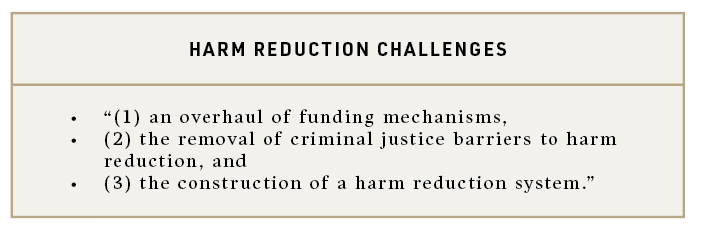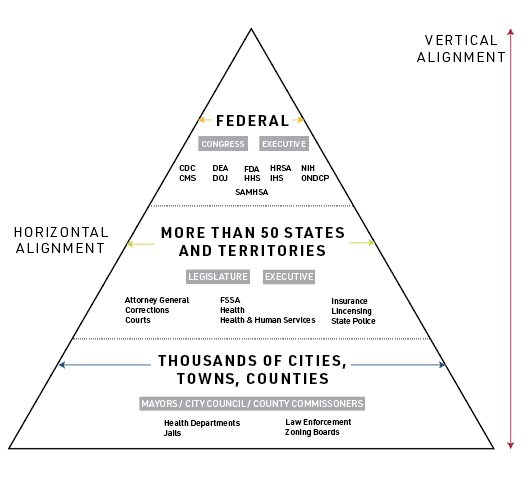By Jon Larsen and Sterling Johnson
Harm reduction in the context of the opioid crisis is focused on preventing overdose and infectious disease transmission by working with people who use drugs without moral judgment. Far too often, the public health imperative of harm reduction is blocked by federal policy, state laws, and other structural barriers anchored in the “war on drugs” that reduce the effectiveness of harm reduction efforts. To maximize the potential of harm reduction requires a whole-of-government approach, involving coordination across levels of government.
As noted in this recent report, “Bringing the W-G approach to bear on a complex problem depends on several components, including agreement as to the problem, understanding the problem, and the causes of the problem. For many involved in government at all levels, the harm reduction challenge unfortunately falls at the first of those hurdles."

With support from the Foundation for Opioid Response Efforts (FORE), public health law experts from Indiana University McKinney School of Law and the Temple University Center for Public Health Law Research at the Beasley School of Law recently embarked on a systematic review of U.S. drug policy using a whole-of-government (W-G) approach to assess where these misalignments are occurring among different agencies at the same level of government (referred to as horizontal W-G), and across different levels of government (referred to as vertical W-G). It ultimately provides a tool to address these misalignments directly.
From that work we identified and published 84 opportunities for U.S. drug policy reform at the federal, state, and local levels across four domains: drug policing, harm reduction, social determinants of health, and health care.
The six opportunities below represent shovel-ready actions that could be taken to support the harm reduction response to the opioid crisis. To access the other 11 opportunities regarding harm reduction and to learn more about the rationale behind these opportunities, visit https://phlr.org/product/legal-path-whole-government-opioids-response.

Federal Government Opportunities:
- Congress can address gaps in access to opioid use disorder health care caused by a lack of public or private insurance by enacting a funding program similar to the Ryan White HIV/AIDS Program, by which services are provided through “payor of last resort” federal funds for low-income people, the uninsured, or underserved, 42 U.S. Code § 300ff–27(b)(7)(F).
- SAMHSA and CMS can issue joint guidance to establish a “braiding” framework for federal funding of state substance use services working with single agency points of contact in the states to reduce funding gaps and improve coordination, as recommended by the Bipartisan Policy Center (Combating the Opioid Crisis, ‘Smarter Spending’ To Enhance The Federal Response. 2022).
State Government Opportunities:
- States can reform their drug laws by repealing paraphernalia laws (Minn. Stat. § 152.092, repealed by SF 2909) or, at the least, amend them to exclude testing strips (e.g., Colo. Rev. Stat. 18-18-426) and needles, syringes, or other supplies obtained from or returned to a Syringe Services Program (SSP) (e.g., N.C. Gen. Stat. § 90-113.27(c)).
- States can enact the Model Syringe Services Program Act that includes expanded SUD treatment provision and referral, measures to reduce needlestick injuries, data collection and reporting requirements for SSPs, immunity for criminal arrest, charge, and prosecution for possession, distribution, and furnishing of hypodermic needles and syringes, as well as harm reduction training for first responders, and funding to support programming.
Local Government Opportunities:
- Local governments can integrate SSPs and remove any special zoning requirements for SSPs and opioid treatment programs (OTPs).
- Municipalities can use local health authority to authorize the use of overdose prevention centers (OPCs), offering people who use drugs safe access to clinical services, like the center established in New York City.
The legal opportunities highlighted above address federal and state harm reduction policy misalignments by seeking to establish a true harm reduction system through more consistent health care access for people who use drugs, better coordination of federal and state funds dedicated to harm reduction, and reductions in barriers to the operation of syringe service programs, OPCs, and OTPs. Each opportunity represents a different but related lever, which work best when done in concert — other opportunities regarding social determinants of health will be considered in a final blog post in this series.
Examples of federal, state, and local government agencies that should interact to promote a Whole-of-Government approach
Jon Larsen, JD/MPP, is a Legal Program Manager at the Center for Public Health Law Research at Temple University Beasley School of Law.
Sterling Johnson, JD, MA is a Research Analyst at the Center for Public Health Law Research at Temple University Beasley School of Law and a Ph.D. Student at Temple University’s Department of Geography.
This blog first appeared on the Bill of Health blog from the Petrie-Flom Center at Harvard Law School.

